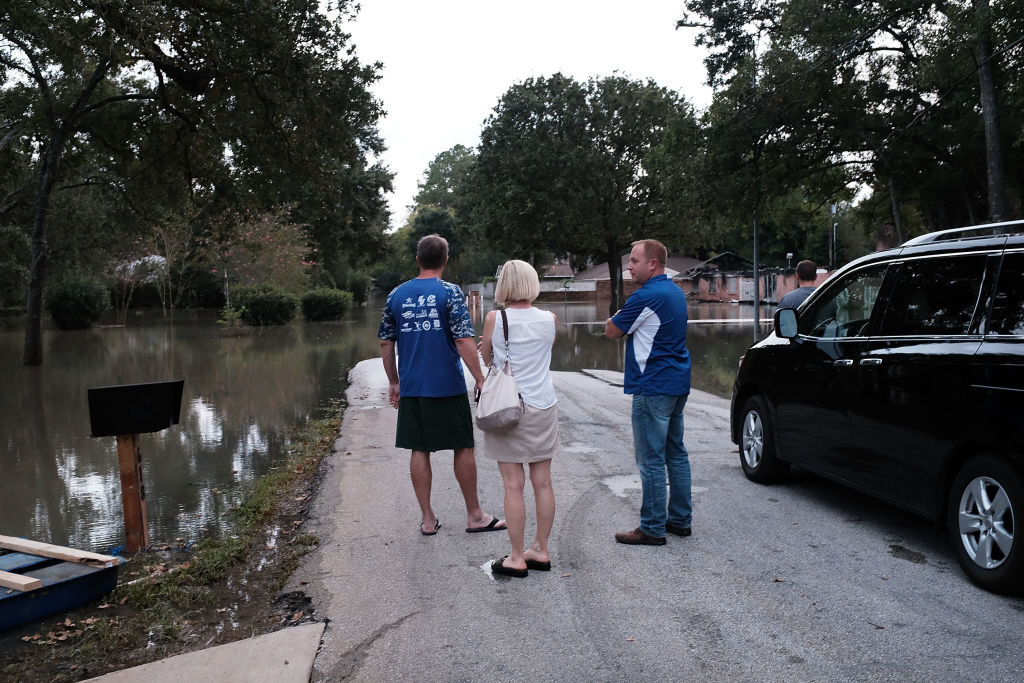Why Texans Heard Conflicting Messages About Evacuating Ahead Of Hurricane Harvey
“Your safest option is to stay put.” This message from Houston-area emergency management officials is difficult to reconcile with images of elderly nursing home residents sitting in waist-deep water and boat rescues of families stranded in the heart of the city.
As Harvey’s unprecedented impacts set in, questions linger about the lack of pre-event mandatory evacuation orders from authorities in Houston and towns farther south along the Texas coast. Despite facing a direct hit from the storm, the city of Corpus Christi and Nueces County issued only voluntary evacuations. The next seven counties to the north and seven surrounding cities – including Rockport, where the hurricane made landfall – issued mandatory evacuations.
Some officials’ messages were stark. Rockport Mayor Pro Tem Patrick Rios warned, “We can’t emphasize enough that this is a life-threatening storm. All the advice we can give is get out now.” Others were more ambiguous. City of Corpus Christi Mayor McComb told the media, “We could mandate it, but people need to make a decision of their own. I’m not going to risk our police and fire people going to try and drag somebody out of the house if they don’t want to go.” McComb did ask residents to voluntarily retreat, especially from low-lying areas.
Mayor McComb strongly encourages evacuation, especially the low lying areas of Area A and B as seen in the map below (pink and yellow area). pic.twitter.com/Z5gspafgSn
— CityOfCorpusChristi (@cityofcc) August 24, 2017
What explains why some local authorities mandate evacuations and others do not? From my study of Gulf Coast emergency managers and elected officials, I know that evacuation decisions are complex. They require assessing many factors beyond weather predictions. We should not expect all leaders to follow the same script, because decisions should be tailored to local communities. But Harvey has shown that there is certainly room for improvement.
Weighing risks and resources
Evacuation decisions require local officials to carefully weigh hazard risk against local response capacity within a tight time period. Harvey’s characteristics made this judgment especially complex.
Fueled by warmer-than-average Gulf waters, Harvey grew in 72 hours from a scattered tropical depression to a Category 4 hurricane. Its path post-landfall was hard to forecast because “steering currents” in the upper atmosphere were extremely weak. Rainfall predictions changed considerably as Harvey approached landfall, and forecasters were unsure where the heaviest rainfall would occur. Hurricane models began to converge on the idea that rainfall amounts were going to be exceptionally high only 36 hours before the storm hit.
At that point, as former Houston Mayor Bill White explained earlier this week, local decisions become “very difficult.” The situation echoed New Orleans Mayor Ray Nagin’s evacuation order 19 hours before Hurricane Katrina struck the city in 2005. When Nagin acted, there was not enough time for residents to muster the resources they needed to move or get help to evacuate. When Katrina made landfall, 70,000 individuals were stranded in the city.
Evacuations may either help or hinder emergency responders. Disasters, by definition, are hazard events that overwhelm local resources. Mandatory evacuations may make the most sense in rural communities, like those around Corpus Christi, where local authorities recognize they do not have the capability to effectively respond to a severe event.
For larger urban areas, evacuations can be extremely expensive, and in worst-case scenarios can create emergencies of their own. Houston Mayor Sylvester Turner was haunted by his city’s evacuation before Hurricane Rita in 2005, in which 100 people died. Turner advised citizens to “think twice before leaving Houston en masse” ahead of Harvey.
Complexity of evacuation calculations
There is no formula for these risk/capacity calculations. They are ultimately made by public officials who have their own situational awareness, based on past experiences and their individual ability to process complexity. Personal or organizational worldviews about disasters and resilience, as well as the legality and ethics of ordering mandatory evacuations, may shape their decisions. Some leaders see evacuations as part of government’s role as a provider and as a form of assistance. Others, like the mayor of Corpus Christi, see it as telling private property owners what to do.
Evacuation calls are also informed by community views about disasters, which are rooted in experiences with past disaster events, local knowledge of hazards, and prevailing culture and norms. This is precisely why state officials say that local leaders know best. These considerations can pose dilemmas for local elected officials, though. As they know, citizens are likely to resent an evacuation order that proves to be unnecessary.
Learning from Harvey
As floodwaters from Harvey recede and communities begin the long process of recovery, it will be important to assess decisions that were made about evacuations, and determine whether – and at what point in time and storm severity – they could have been more effective.
Another key question is how people perceive and respond to gaps in mandatory evacuations, like those in Corpus Christi and Houston. Were there substantial numbers of “shadow evacuations,” in which people outside of mandatory evacuation zones moved voluntarily? Did households take other preparatory actions in lieu of retreating, and were they effective?
It is critical to revisit the days and hours before Harvey made landfall to identify ways of improving communication by local government agencies. How did it affect Houston-area residents when Texas Governor Greg Abbott encouraged them to retreat while city officials told them to stay home?
Beyond decisions in the countdown to the storm, there are other hard questions. Why is there hostility in Corpus Christi toward mandatory evacuations? What might shift that community’s thinking about risk? And why is it logistically unfeasible to safely evacuate Houston’s most vulnerable and exposed residents en masse? Evacuating all six million residents from the Houston area is unthinkable. But how can we Texans improve our transportation infrastructure and systems to effectively evacuate very large groups, and even entire communities? That could involve options like the hotly contested high-speed railwaythat a private developer wants to build from Houston to Dallas. This may require public investment that state lawmakers were unwilling to commit in the most recent legislative session.
Texans have been tough in the face of one hell of a storm. Now it’s time to find creative solutions so that we emerge even stronger.
###
This story by Ashley Ross originally appeared in The Conversation.





